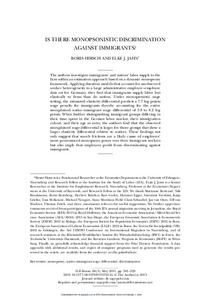Is there monopsonistic discrimination against immigrants?

2015
68
3
May
501-528
discrimination ; immigrant ; wage differential
Wages and wage payment systems
http://dx.doi.org/10.1177/0019793915572124
English
Bibliogr.
"The authors investigate immigrants' and natives' labor supply to the firm within an estimation approach based on a dynamic monopsony framework. Applying duration models that account for unobserved worker heterogeneity to a large administrative employer–employee data set for Germany, they find that immigrants supply labor less elastically to firms than do natives. Under monopsonistic wage setting, the estimated elasticity differential predicts a 7.7 log points wage penalty for immigrants thereby accounting for the entire unexplained native–immigrant wage differential of 5.8 to 8.2 log points. When further distinguishing immigrant groups differing in their time spent in the German labor market, their immigration cohort, and their age at entry, the authors find that the observed unexplained wage differential is larger for those groups that show a larger elasticity differential relative to natives. These findings not only suggest that search frictions are a likely cause of employers' more pronounced monopsony power over their immigrant workers but also imply that employers profit from discriminating against immigrants."
Digital
The ETUI is co-funded by the European Union. Views and opinions expressed are however those of the author(s) only and do not necessarily reflect those of the European Union or the ETUI.